
A set of primary colors or primary colours consists of colorants or colored lights that can be mixed in varying amounts to produce a gamut of colors. This is the essential method used to create the perception of a broad range of colors in, e.g., electronic displays, color printing, and paintings. Perceptions associated with a given combination of primary colors can be predicted by an appropriate mixing model that reflects the physics of how light interacts with physical media, and ultimately the retina.

Magenta is a color that is variously defined as pinkish-purplish-red, reddish-purplish-pink or mauvish-crimson. On color wheels of the RGB (additive) and CMY (subtractive) color models, it is located exactly midway between red and blue. It is one of the four colors of ink used in color printing by an inkjet printer, along with yellow and cyan, to make all other colors. The tone of magenta used in printing is called "printer's magenta".
Pantone LLC is an American limited liability company headquartered in Carlstadt, New Jersey. The company is best known for its Pantone Matching System (PMS), a proprietary color space used in a variety of industries, notably graphic design, fashion design, product design, printing and manufacturing and supporting the management of color from design to production, in physical and digital formats, among coated and uncoated materials, cotton, polyester, nylon and plastics.

Crayola LLC, formerly the Binney & Smith Company, is an American manufacturing company specializing in art supplies. It is known for its brand Crayola and best known for its crayons. The company is headquartered in Forks Township, Pennsylvania in the Lehigh Valley region of the state. Since 1984, Crayola has been a wholly owned subsidiary of Hallmark Cards.
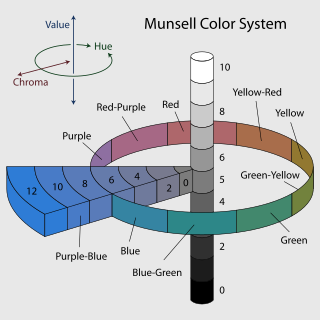
In colorimetry, the Munsell color system is a color space that specifies colors based on three properties of color: hue, chroma, and value (lightness). It was created by Professor Albert H. Munsell in the first decade of the 20th century and adopted by the United States Department of Agriculture (USDA) as the official color system for soil research in the 1930s.
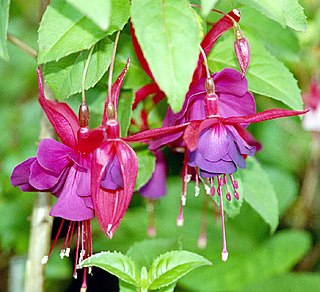
Fuchsia is a vivid pinkish-purplish-red color, named after the color of the flower of the fuchsia plant, which was named by a French botanist, Charles Plumier, after the 16th-century German botanist Leonhart Fuchs.
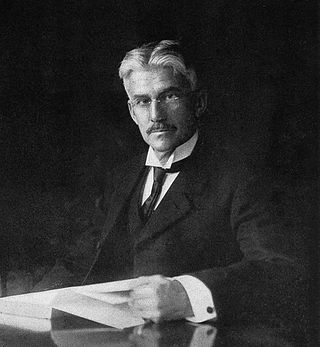
Albert Henry Munsell was an American painter, teacher of art, and the inventor of the Munsell color system.
A color model is an abstract mathematical model describing the way colors can be represented as tuples of numbers, typically as three or four values or color components. When this model is associated with a precise description of how the components are to be interpreted, taking account of visual perception, the resulting set of colors is called "color space."
Henry Hemmendinger was an American color scientist.
X-Rite, Inc. is an American manufacturer of color measurement and management products, located in Grand Rapids, Michigan, United States.
Elliot Quincy Adams was an American scientist. Chemist Gilbert N. Lewis remarked that "the two most profound scientific minds, among the people he had known, were those of E[lliot] Q Adams and Albert Einstein."

Varieties of the color red may differ in hue, chroma or lightness, or in two or three of these qualities. Variations in value are also called tints and shades, a tint being a red or other hue mixed with white, a shade being mixed with black. A large selection of these various colors are shown below.
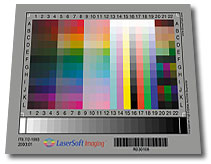
A color chart or color reference card is a flat, physical object that has many different color samples present. They can be available as a single-page chart, or in the form of swatchbooks or color-matching fans.
Color analysis, also known as personal color analysis (PCA), seasonal color analysis, or skin-tone matching, is a term often used within the cosmetics and fashion industry to describe a method of determining the colors of clothing, makeup, hair style that harmonizes with a person's skin complexion, eye color, and hair color for use in wardrobe planning and style consulting. It is generally agreed that the wrong colors will draw attention to such flaws as wrinkles or uneven skin tone while harmonious colors will enhance the natural beauty of the individual making them appear healthy, brighter, and possible more attactive or put-together.

The ColorChecker Color Rendition Chart is a color calibration target consisting of a cardboard-framed arrangement of 24 squares of painted samples. The ColorChecker was introduced in a 1976 paper by McCamy, Marcus, and Davidson in the Journal of Applied Photographic Engineering. The chart’s color patches have spectral reflectances intended to mimic those of natural objects such as human skin, foliage, and flowers, to have consistent color appearance under a variety of lighting conditions, especially as detected by typical color photographic film, and to be stable over time.

Varieties of the color blue may differ in hue, chroma, or lightness, or in two or three of these qualities. Variations in value are also called tints and shades, a tint being a blue or other hue mixed with white, a shade being mixed with black. A large selection of these colors are shown below.
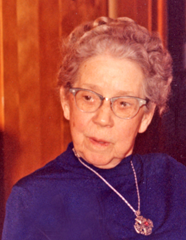
Dorothy Nickerson was an American color scientist and technologist who made important contributions in the fields of color quality control, technical use of colorimetry, the relationship between color stimuli and color perceptions, standardization of light sources, color tolerance specification, and others.

There are numerous variations of the color purple, a sampling of which are shown below.

The Farnsworth–Munsell 100 Hue Color Vision test is a color vision test often used to test for color blindness. The system was developed by Dean Farnsworth in the 1940s and it tests the ability to isolate and arrange minute differences in various color targets with constant value and chroma that cover all the visual hues described by the Munsell color system. There are several variations of the test, one featuring 100 color hues and one featuring 15 color hues. Originally taken in an analog environment with physical hue tiles, the test is now taken from computer consoles. An accurate quantification of color vision accuracy is particularly important to designers, photographers and colorists, who all rely on accurate color vision to produce quality content.
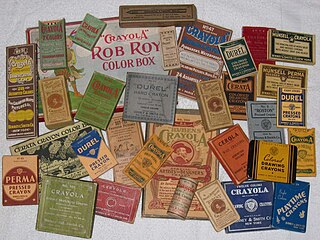
Since the introduction of Crayola drawing crayons by Binney & Smith in 1903, more than two hundred distinctive colors have been produced in a wide variety of assortments. Crayola became such a hit because the company figured out a way to inexpensively combine paraffin wax with safe pigments. The line has undergone several major revisions in its history, notably in 1935, 1949, 1958, and 1990. Numerous specialty crayons have also been produced, complementing the basic Crayola assortment.










